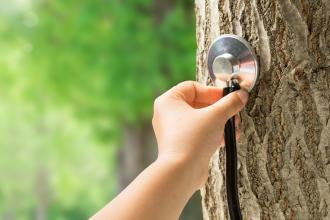Forest fires: A clinician primer
Wildfire smoke poses public health risks for populations both near to and far from the direct threat of fire. Here we offer evidence-based responses to clinicians’ questions on the health effects of smoke, and highlight tools for situational awareness and public preparedness during wildfire events.
Who is exposed to wildfire smoke?
Wildfire smoke causes episodes of the worst air quality that most rural and urban Canadian populations will ever experience. Both rural and urban populations can be affected by wildfire smoke, although exposures may be higher and last longer in rural areas that are closer to fires.
What is in wildfire smoke?
Wildfire smoke is a complex mixture of fine particulate matter (PM2.5), carbon monoxide (CO), volatile organic compounds (VOCs), and other air toxins such as heavy metals. The constituents of smoke can lead to the formation of ground-level ozone (O3) on sunny days. PM2.5 is the principal public health threat from short-term smoke exposure.
What health effects are most associated with wildfire smoke exposure?
- Irritation of the upper mucosa, especially to the eyes and throat.
- Exacerbation of chronic diseases such as asthma, COPD, and heart disease, especially in those whose disease is severe or poorly controlled.
- Small increases in all-cause mortality.
- Reduced birth weight.
Who is at increased risk for adverse health effects from wildfire smoke?
- Anyone with a chronic condition that affects their day-to-day health, especially respiratory or cardiovascular diseases.
- Pregnant women.
- Infants, young children, and elderly people.
Are air cleaners effective?
Air cleaners with HEPA filters or electrostatic precipitators can lower indoor concentrations of PM2.5 and reduce symptoms. Their effectiveness depends on the intensity of the smoke, room size, air exchange rate, and their placement within the room.
Tools for situational awareness in BC
- National smoke forecasts: http://firesmoke.ca/forecasts/BSC00CA12/current and https://weather.gc.ca/firework.
- Real-time air-quality monitoring, including the Air Quality Health Index: www.bcairquality.ca/readings/index.html.
- Real-time assessment of the smell and visibility of smoke.
- Smoky-skies advisories issued when smoke is likely to have transient effects on local air quality.
How can individuals protect themselves from the health effects of wildfire smoke?
We cannot control wildfire smoke, so the best defence is to be prepared.
- People with chronic diseases should carry rescue medications at all times, keep extras at home, and know what to do if they cannot bring symptoms under control.
- Buy a home air cleaner with a HEPA filter or electrostatic precipitator before the smoke arrives, or seek cleaner air in large public buildings.
- Reduce outdoor activities and physical exertion.
- Stay hydrated.
How can clinicians protect their patients?
- Talk to patients about the risks of wildfire smoke and the benefits of home air cleaners.
- Update self-management plans for chronic diseases, and update prescriptions for maintenance and rescue medications before the fire season begins.
The BC Centre for Disease Control leads internationally recognized epidemiologic research and public health surveillance related to wildfire smoke. We have been the first to demonstrate the utility of smoke forecasts[1,2] for public health protection, and the first to implement passive surveillance systems using satellite imagery and pharmaceutical data. The BC Asthma Monitoring System has been recognized by Accreditation Canada as a leading public health practice, with weekly reports made available to medical health officers across the province during the fire season.[2]
—Hortense Tabien Nsoh, MD
—Sarah B. Henderson, PhD
—Tom Kosatsky, MD
hidden
This article is the opinion of the BC Centre for Disease Control and has not been peer reviewed by the BCMJ Editorial Board.
References
1. Yao J, Brauer M, Henderson SB. Evaluation of a wildfire smoke forecasting system as a tool for public health protection. Environ Health Perspect 2013;121:1142-1147.
2. McLean KE, Yao J, Henderson SB. An evaluation of the British Columbia Asthma Monitoring System (BCAMS) and PM2.5 exposure metrics during the 2014 forest fire season. Int J Environ Res Public Health 2015;12:6710-6724.
Additional resources
Asthma Society of Canada. Asthma Action Plan. Accessed 31 May 2016. www.asthma.ca/adults/control/pdf/AsthmaActionPlan_ENG.pdf.
BCCDC. Evidence review: Home and community clean air shelters to protect public health during wildfire smoke events, 31 March 2014. Accessed 31 May 2016. www.bccdc.ca/resource-gallery/_layouts/15/DocIdRedir.aspx?ID=BCCDC-288-5635.
BCCDC. Evidence review: Wildfire smoke and public health risk, 31 March 2014. Accessed 31 May 2016. www.bccdc.ca/resource-gallery/Documents/Guidelines%20and%20Forms/Guidelines%20and%20Manuals/Health-Environment/WFSG_EvidenceReview_WildfireSmoke_FINAL_v3_edstrs.pdf.
BCCDC. Guidance for BC public health decision making during wildfire smoke events, September 2014. Accessed 31 May 2016. www.bccdc.ca/resource-gallery/_layouts/15/DocIdRedir.aspx?ID=BCCDC-288-5634.
Health Canada. It’s way too hot! Protect yourself from extreme heat. Accessed 31 May 2016. www.hc-sc.gc.ca/ewh-semt/pubs/climat/heat-adults-chaleur/index-eng.php.
Northern Saskatchewan Population Health Unit. Guidelines for health staff in Northern Saskatchewan communities: Preparation for forest fires and the assessment of health effects from forest fire smoke. Accessed 31 May 2016. www.pnwbha.org/wp-content/uploads/2012/07/SMOKE-and-Fire-Guidelines-2012.pdf.

